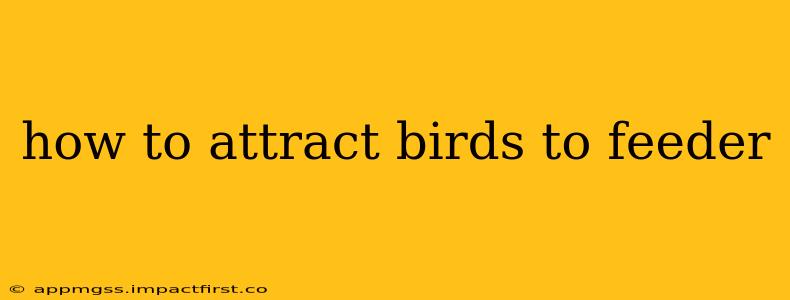Want to transform your backyard into a vibrant avian haven? Attracting birds to your feeder is a rewarding experience, bringing beauty and life to your outdoor space. This comprehensive guide will equip you with the knowledge and strategies to successfully attract a diverse range of feathered friends. We'll cover everything from choosing the right feeder to providing the perfect food and creating a bird-friendly environment.
What Type of Bird Feeder Should I Use?
The type of bird feeder you choose significantly impacts which species you attract. Different feeders cater to different bird feeding styles.
- Tube feeders: These are popular and offer a variety of seed types, attracting smaller birds like finches, chickadees, and nuthatches.
- Platform feeders: Ideal for larger birds like doves and jays, these offer easy access to seeds and suet. They're also a good choice for birds who prefer to feed on the ground.
- Hopper feeders: These larger feeders hold substantial amounts of seed, often with multiple feeding ports, attracting a variety of birds.
- Suet feeders: Suet is a high-energy food source, particularly beneficial during winter. Suet feeders attract woodpeckers, nuthatches, and other insect-eating birds.
Consider the size and species of birds you hope to attract when making your selection.
What Kind of Birdseed Should I Use?
Offering a variety of seeds will attract a wider range of birds. Popular options include:
- Sunflower seeds (black oil): A favorite among many species, these are high in oil and provide essential nutrients.
- Nyjer seeds (thistle): A tiny seed that attracts goldfinches and other small birds. Use a specialized feeder designed for these seeds.
- White-striped sunflower seeds: A larger seed, often preferred by larger birds.
- Milo: A grain that attracts doves and sparrows.
- Cracked corn: Another grain that attracts ground-feeding birds.
Avoid using low-quality mixed seeds, as they often contain filler that birds won't eat.
Where Should I Place My Bird Feeder?
Placement is crucial for attracting birds and ensuring their safety.
- Location: Place your feeder at least 3-4 feet from trees and shrubs to minimize predation by cats or other predators.
- Visibility: Choose a location visible from your windows for enjoyable birdwatching.
- Shelter: Offer some protection from the elements, particularly harsh winds and rain.
- Height: The ideal height varies depending on the type of feeder and the birds you want to attract. Experiment with different heights to see what works best.
Regularly clean and maintain your feeder to prevent the spread of disease.
How Often Should I Refill My Bird Feeder?
The frequency of refilling depends on the size of your feeder, the number of birds visiting, and the type of seed you're using. Aim to keep your feeder at least half full, especially during colder months when birds need more energy.
What Other Things Can I Do to Attract Birds?
Providing a bird-friendly environment beyond just food is key to attracting a variety of species.
- Provide a water source: Birds need a reliable source of fresh water for drinking and bathing. A birdbath or shallow dish of water will attract many birds.
- Plant native plants: Native trees, shrubs, and flowers provide natural food sources like berries, seeds, and insects.
- Offer nesting materials: Birds require materials like twigs, string, and hair for building nests. Providing these materials can encourage birds to nest nearby.
- Avoid pesticides: Pesticides can harm birds and their food sources. Opt for natural pest control methods.
How Can I Keep Squirrels Away From My Bird Feeder?
Squirrels are notorious for raiding bird feeders. Here are a few strategies to deter them:
- Squirrel-resistant feeders: These feeders are designed with features to prevent squirrels from accessing the food.
- Baits: Place squirrel-specific food away from the bird feeder to distract them.
- Physical barriers: Use cages or baffles to prevent squirrels from reaching the feeder.
What if I Don't See Many Birds at My Feeder?
If you’re not seeing many birds, don’t be discouraged! It may take time for birds to discover your feeder. Persistence is key. Continue to offer high-quality food, provide a safe and comfortable environment, and be patient – you'll soon be enjoying the beauty of birds in your backyard.
This comprehensive guide provides a strong foundation for attracting birds to your feeder. Remember, consistent effort and a bird-friendly environment are crucial for creating a thriving avian community in your backyard.
